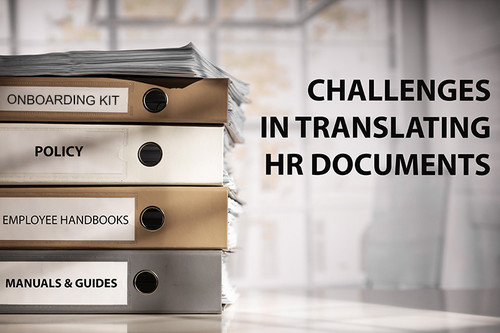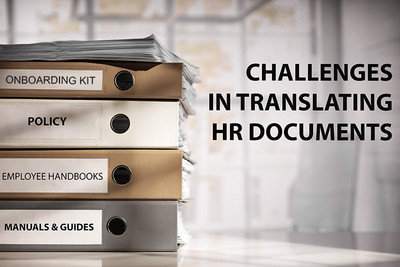The Complete Guide to Translating HR Documents for Your Business in 2025


4 MIN READ
Written by Natalia Basiuk, follow her on LinkedIn.
This comprehensive guide will walk you through every aspect of HR document translation, from understanding the different types of materials that require translation to implementing quality assurance processes that ensure your workforce receives clear, accurate, and culturally appropriate information.
Understanding Different Types of HR Materials
HR documents cover everything from company policies and benefits to disciplinary procedures and workplace conduct. They set the tone for how your employees interact, perform, and grow within the company.
Employee Handbooks and Manuals
Employee manual translation services form the backbone of HR translation needs. Employee handbooks serve as the primary reference document for workplace policies, procedures, and expectations. When you translate employee handbook materials, you're ensuring that every employee, regardless of their native language, has equal access to critical information about:
- Company policies and procedures
- Code of conduct and ethics
- Benefits and compensation details
- Leave policies and procedures
- Health and safety protocols
- Performance evaluation processes
Specialized HR Guides and Policies
HR guide translation encloses a broader range of materials beyond the standard employee handbook. These specialized documents often require even more precise translation due to their technical nature:
Training and Development Materials: Onboarding guides, skills development programs, and professional development resources require employee guide translation that maintains both educational value and cultural relevance.
Policy Documents: HR policies translation covers specific organizational rules and regulations that must be translated with legal precision. This includes anti-discrimination policies, harassment prevention guidelines, and disciplinary procedures.
Operational Guides: HR manuals translation extends to operational documents that guide daily workplace functions, from timekeeping procedures to equipment usage guidelines.
Compliance and Legal Documents
The most challenging aspect of handbook translation often involves legal and compliance materials. These documents must not only be linguistically accurate but also legally sound in the target jurisdiction. This includes: employment contracts and agreements, safety protocols and compliance materials, workers' compensation information and privacy policies and data protection guidelines.
Key Challenges in HR Translation
Legal and Regulatory Complexity
One of the most significant challenges in HR documents translation is navigating the complex web of employment laws that vary by country, state, and even municipality. When companies translate employee handbook materials, they must ensure that translated policies comply with local labor laws while maintaining the intent of the original document.
Cultural Sensitivity and Context
HR guide translation requires more than linguistic accuracy; it demands cultural intelligence. Workplace norms, communication styles, and even concepts of hierarchy vary dramatically in different cultures. What might be considered direct and clear communication in one culture could be perceived as rude or inappropriate in another. Professional translators specializing in HR manuals translation must consider: cultural attitudes toward authority and hierarchy, communication preferences (direct vs. indirect), religious and cultural holidays, gender roles and workplace expectations, concepts of work-life balance.
Technical Terminology and Consistency
HR documents are filled with specialized terminology that must be translated consistently across all materials. HR policies translation requires maintaining a unified glossary of terms to ensure that all concepts are translated identically throughout all documents.
Maintaining Document Structure and Usability
When you translate employee handbook materials, preserving the document's structure and navigability is crucial. Employees need to quickly find specific information, which means maintaining: table of contents accuracy, cross-references and hyperlinks, formatting and visual hierarchy, searchable content organization.
Step-by-Step Translation Process
Document Analysis and Preparation
Before beginning any handbook translation project, conduct a thorough analysis of your source materials: content audit, legal review, glossary development, target audience analysis.
Selecting Translation Approach
Professional vs. In-House Translation: While some organizations consider using bilingual employees for employee guide translation, professional employee manual translation services offer several advantages: specialized knowledge of HR terminology, understanding of legal requirements, quality assurance processes, consistency across large projects, and a variety of languages
Translation Method Selection: Choose between human translation, machine translation with human post-editing, or hybrid approaches based on document sensitivity and budget constraints.
Translation Execution
Professional translators with HR expertise complete the initial HR documents translation, focusing on accuracy, cultural appropriateness, and legal compliance.
Quality Review - multiple review stages ensure accuracy:
- Linguistic review for grammar and style
- Technical review for HR terminology consistency
- Cultural review for appropriateness
- Legal review for compliance
- Formatting and Layout - ensure translated documents maintain a professional appearance and usability
Choosing the Right Translation Service
Whether you’re looking to translate an employee handbook, localize company policies, or deliver comprehensive HR guide translation, partnering with an experienced provider ensures success and when choosing the best translation service for employee manual translation, consider these critical factors:
HR Specialization: Look for providers with specific experience in HR manuals translation rather than general translation services.
Legal Expertise: Ensure translators understand employment law in both source and target jurisdictions.
Cultural Competency: Verify that the service can provide culturally appropriate HR policies translation.
Quality Assurance: Confirm review processes and quality control measures
Here is the checklist of questions to ask potential translation providers:
What experience do you have with handbook translation in our industry?
How do you ensure consistency in terminology in large HR documents translation projects?
What quality assurance processes do you use for employee guide translation?
Can you provide references from similar HR guide translation projects?
How do you handle updates and revisions to translated materials?
What measures do you take to ensure the confidentiality of sensitive HR information?
What is your regular turnaround time?
How do you provide ongoing support?
Conclusion
Translating HR documents is a strategic business imperative that is about creating an inclusive workplace where every employee can fully understand their rights, responsibilities, and opportunities. Success in HR documents translation requires a systematic approach that begins with thorough document analysis, continues through careful provider selection based on HR specialization and legal expertise, and maintains quality through rigorous review processes. The investment in professional handbook translation and HR guide translation pays dividends in reduced legal risks, improved employee engagement, and enhanced operational efficiency across diverse markets. Companies that prioritize accurate, culturally appropriate HR policies translation position themselves for sustainable global growth while building trust and clarity with their multilingual workforce. The key to success lies in treating translation not as a one-time task, but as an ongoing strategic process that evolves with your business and workforce needs.





